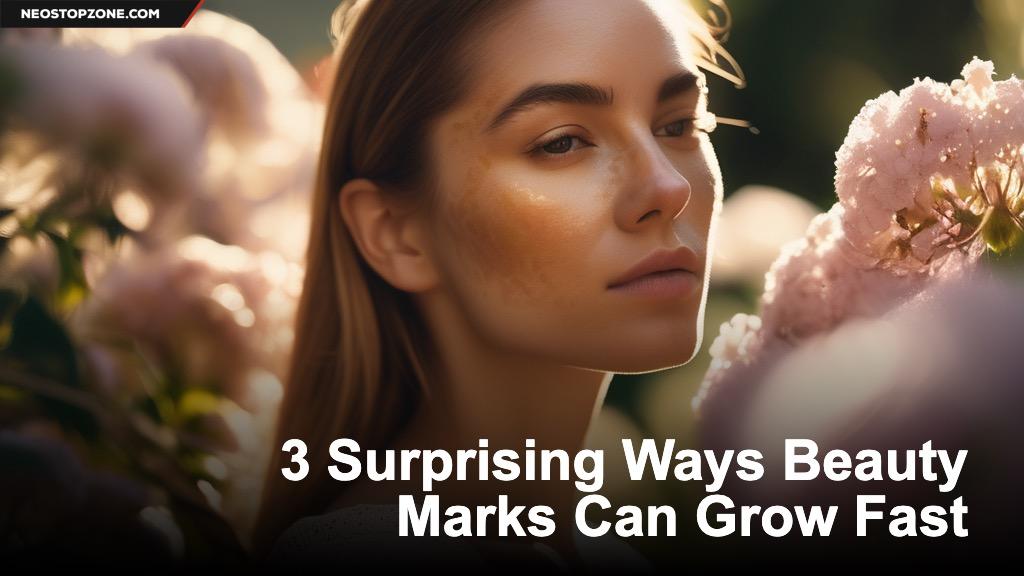
Introduction
Beauty marks, also known as moles, are often considered charming additions to one’s appearance. However, the rapid growth of these marks can be alarming and may signify underlying health concerns. Understanding the factors influencing their growth is crucial for maintaining skin health. In this article, we’ll explore three surprising ways beauty marks can grow fast and what you can do about it.
Understanding Beauty Marks
Beauty marks are small, pigmented spots on the skin that can vary in color and size. They can be classified into different types, including junctional, compound, and dermal moles. The growth of beauty marks is influenced by various factors such as genetics, hormonal changes, and sun exposure.
Surprising Way #1: Hormonal Changes
Hormonal fluctuations, especially during puberty, pregnancy, and menopause, can have a significant impact on skin health. These changes can stimulate the growth of beauty marks due to increased melanin production. Hormonal imbalances can lead to the development of new moles or the enlargement of existing ones.
Surprising Way #2: Sun Exposure
Excessive exposure to ultraviolet (UV) radiation from the sun can accelerate the growth of beauty marks. UV rays can damage the DNA in skin cells, leading to the formation of new moles or the darkening of existing ones. Sunscreen and protective clothing are essential for preventing sun-induced changes in beauty marks.
Surprising Way #3: Genetics
Genetics play a significant role in the development of beauty marks. Individuals with a family history of moles are more likely to develop them at an early age and in larger numbers. Certain genetic mutations can also increase the risk of abnormal mole growth and skin cancer.
Common Misconceptions About Beauty Marks
There are several misconceptions surrounding beauty marks, including the belief that they are indicators of beauty or luck. In reality, beauty marks are simply clusters of pigmented cells and should be monitored for any changes in size, shape, or color. It’s essential to differentiate between benign moles and potentially harmful ones.
Importance of Monitoring Beauty Marks
Regularly monitoring beauty marks is essential for detecting any changes that may indicate skin cancer. The ABCDE rule can help identify suspicious moles: asymmetry, border irregularity, color variation, diameter larger than a pencil eraser, and evolution (changes over time). Early detection and treatment can significantly improve outcomes.
Tips for Managing Beauty Marks
To manage beauty marks effectively, it’s essential to practice sun protection measures such as wearing sunscreen, protective clothing, and avoiding peak sun hours. Regular skin checks can help identify any new or changing moles early on. Consultation with a dermatologist is recommended for individuals with a history of abnormal mole growth or skin cancer.
Case Studies: Real-Life Experiences
Many individuals have shared their experiences with rapid beauty mark growth, highlighting the importance of vigilance and proactive skin care. By staying informed and taking preventive measures, it’s possible to minimize the risks associated with abnormal mole growth and promote overall skin health.
Medical Perspective: Dermatologists’ Insights
Dermatologists emphasize the importance of regular skin checks and early detection of abnormal moles. They may recommend mole mapping, a technique that involves photographing and monitoring moles over time to detect any changes. Treatment options for abnormal moles may include surgical removal or topical medications.
Psychological Impact of Beauty Marks
The presence of beauty marks can have both positive and negative psychological effects on individuals. While some may embrace their marks as unique features, others may feel self-conscious or anxious about their appearance. Promoting self-acceptance and raising awareness about skin health can help reduce stigma and empower individuals to take control of their skin care.
Future Trends in Beauty Mark Research
Advancements in dermatological research continue to improve our understanding of beauty marks and their growth patterns. Emerging technologies such as artificial intelligence and genetic testing hold promise for early detection and personalized treatment approaches. By staying informed and proactive, individuals can stay ahead of potential skin health concerns.
Conclusion
The rapid growth of beauty marks can be surprising and concerning, but understanding the factors influencing their development is key to maintaining skin health. Hormonal changes, sun exposure, and genetics all play significant roles in beauty mark growth. By practicing sun protection, monitoring moles for changes, and seeking medical advice when necessary, individuals can take control of their skin health and minimize the risks associated with abnormal mole growth.
FAQs
1. Can beauty marks disappear on their own?
While some beauty marks may fade or disappear over time, it’s essential to monitor them for any changes that may indicate skin cancer or other health concerns.
2. Are all moles considered beauty marks?
Not all moles are considered beauty marks. Some moles may be considered cosmetic nuisances, while others may require medical attention due to their potential to develop into skin cancer.
3. Can beauty marks be removed?
Yes, beauty marks can be removed through various methods, including surgical excision, laser therapy, and cryotherapy. However, it’s essential to consult with a dermatologist before pursuing any removal procedure.
4. Are beauty marks more common in certain ethnicities?
Yes, the prevalence of beauty marks can vary among different ethnic groups. Individuals with fair skin are more susceptible to developing moles due to their lower levels of melanin.
5. Are all changes in beauty marks cause for concern?
Not all changes in beauty marks are cause for concern, but any changes in size, shape, color, or texture should be evaluated by a dermatologist to rule out skin cancer or other health issues.



